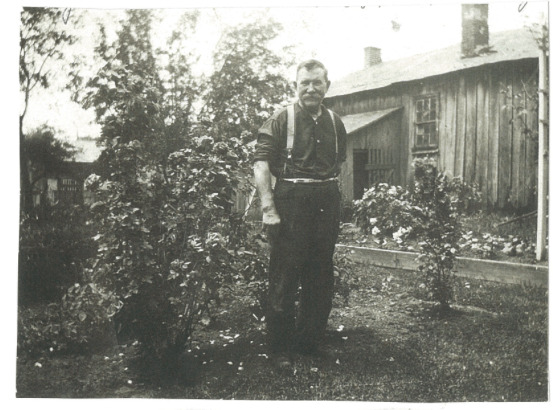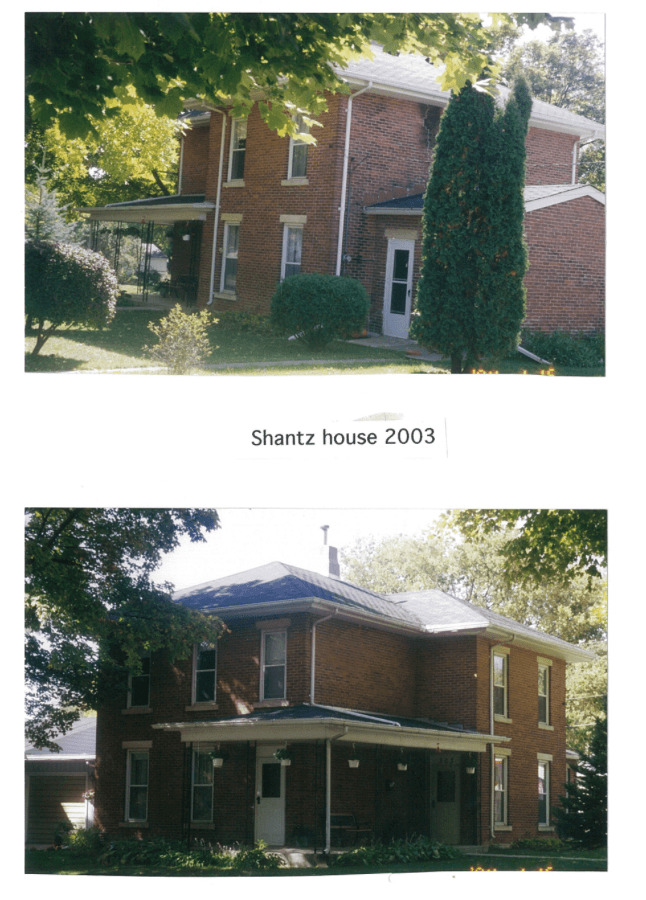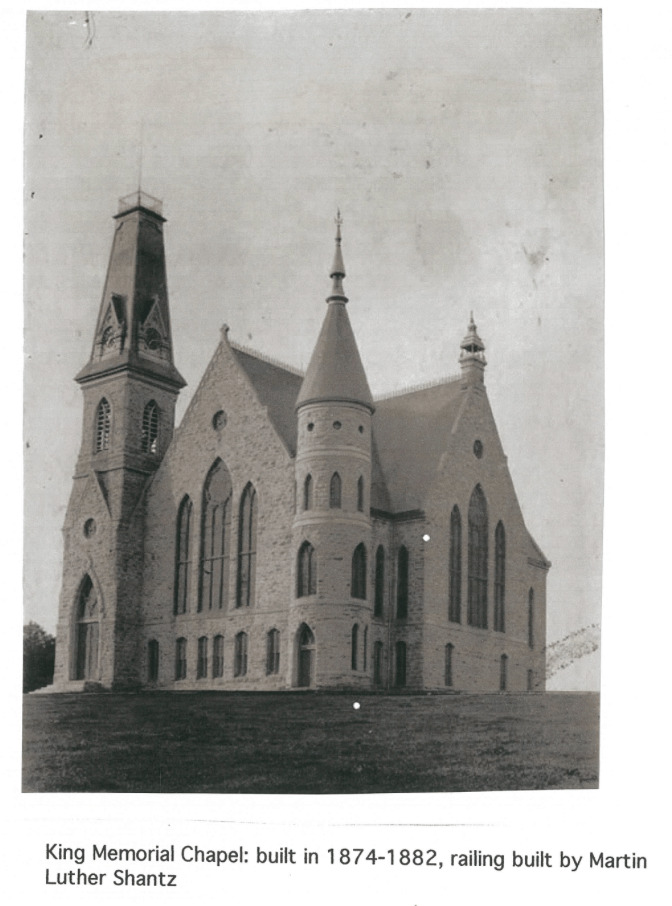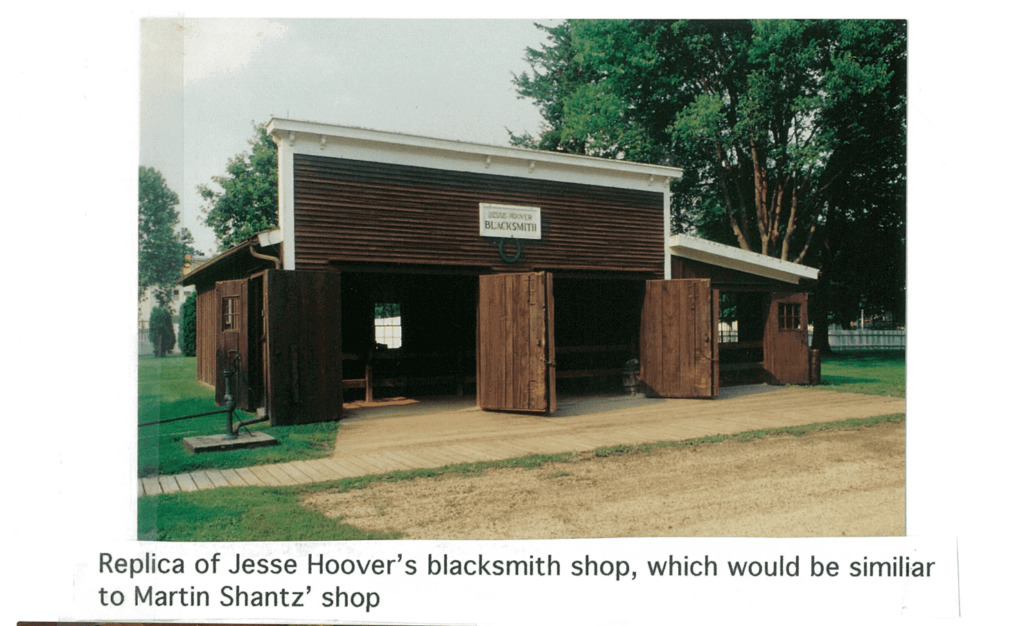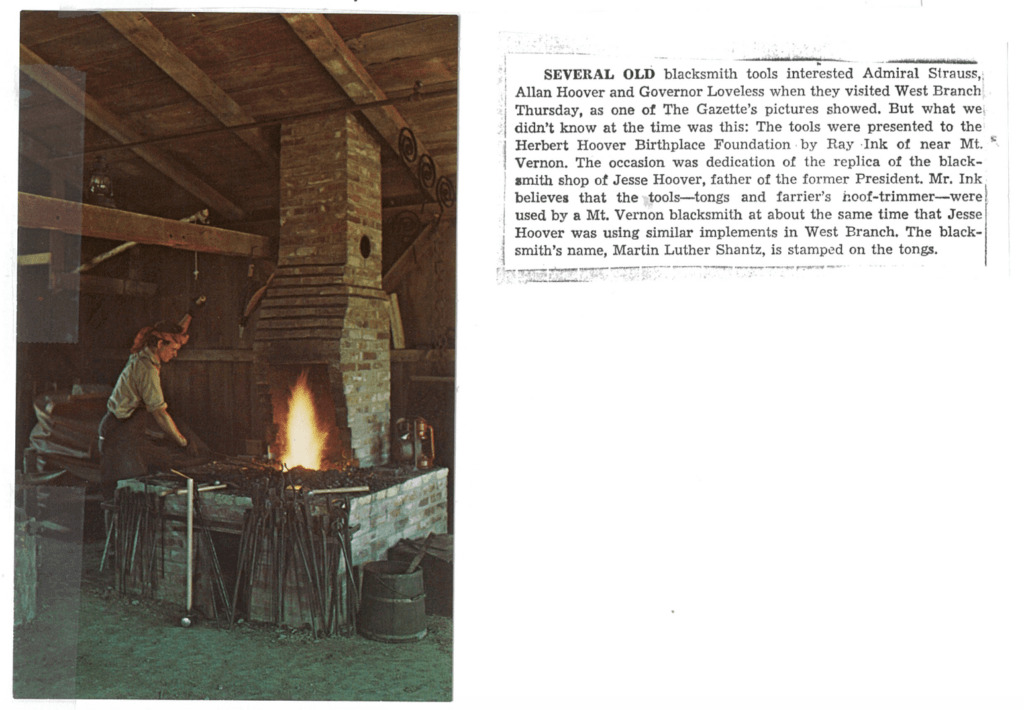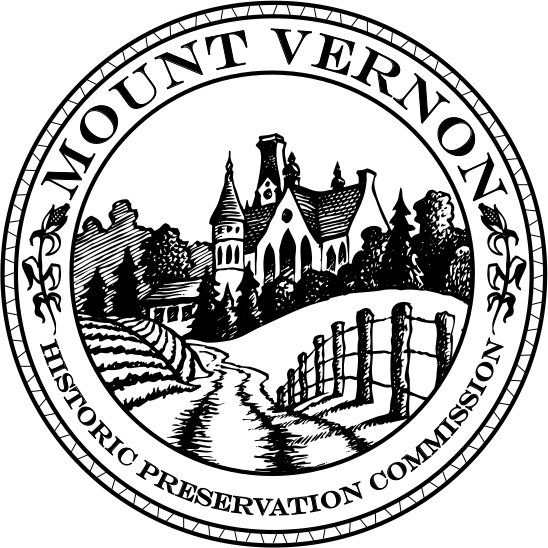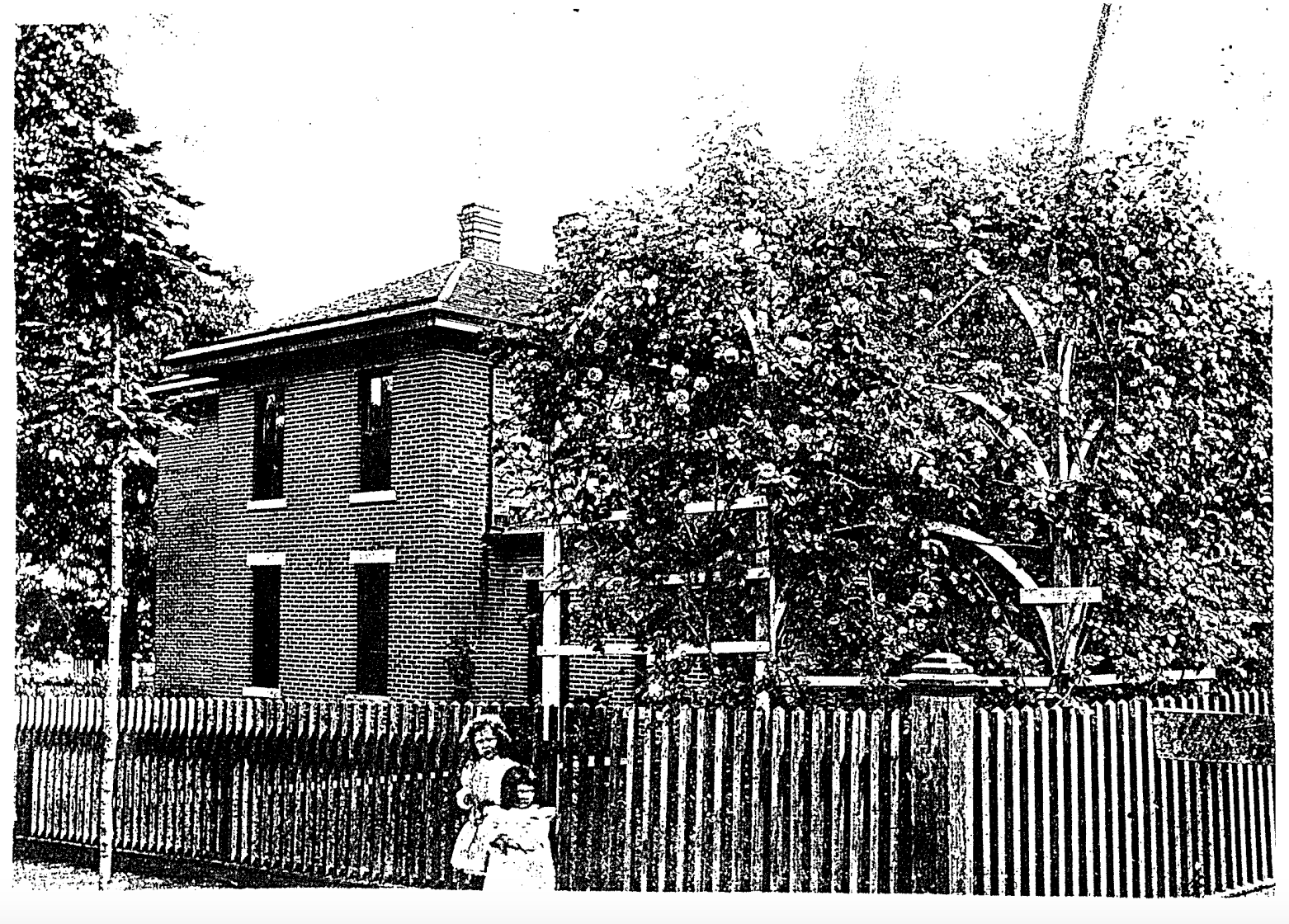by Chris Stoner, October 2003
For my Mount Vernon History Project, I chose the brick house at 303 A Ave. South. This house was built by my great-great-great grandfather Martin Luther Shantz, a blacksmith in Mount Vernon.
When you study the history of a house, you also need to study the people who lived in the house. Martin Luther Shantz was born on May 16, 1844 in Montgomery county, Pennsylvania. His parents were Alice Rambo and John F. Shantz. Martin was the youngest of nine children. He came with his family to Iowa in an ox cart when he was ten, settling on a farm south of Lisbon. His father eventually grew homesick and moved back to Pennsylvania, but Martin stayed behind, for he loved Iowa and a young woman named Mary Jane Yount.
Martin came to Mount Vernon as an apprentice to a blacksmith in 1865. He made horseshoes, wagon wheels, and other iron tools by heating them in a forge kept hot by a bellows. He then hammered the item on an anvil to shape it. Martin also shoed horses, sharpened plows, and made and repaired wagons. He was well respected in the community. A quote from his daughters story quotes citizens saying things such as “No one but Mart shall sharpen my plow or shoe my horses.” His daughter’s story is included later in this report.
Mary Jane Yount was born in Hendricks County, Indiana on February 18, 1845. Her parents were Mr. and Mrs. Braxton Yount, and she had three other siblings. Mary and her family moved to Iowa in 1850, traveling in a covered wagon. They settled near Martelle, and later moved to Mount Vernon.
Mary and Martin were married on June 27, 1867. They had 5 children. Adelbert, their first son, lived only a year and three months. He was born in December 1868, and he died March 15, in the year 1870. Their second child, Geneva, was born on February 7, 1871. Their second daughter was born on May 30, 1875. She died as an infant. Helen, their third daughter, was born on November 1876. Their last child, Harry, was born in 1880.
Martin’s obituary said that they only had four children, but Mary’s said they had five. So we went to Mount Vernon Cemetery to find out. We found three tombstones for the children who had lived to adulthood, and one tombstone with Adelbert’s and their infant child’s birth and death information on it.
Martin and Mary first lived in a little white frame house. We believe this was located just south of the brick house because they also owned this land, and Geneva’s story about they house refer’s to Mary being able to hear Mart working in his nearby shop. His shop we believe was just a little south of the current garage. Their children were born here and two died here in the little house. It’s here that they began planning their dream house. They wanted a parlor with a bay window, and a dining room. Also, they wanted large rooms, and for their house to be made of red brick. It took Martin several hard years to construct the house. When it was finished, the family moved in.
It is difficult to tell exactly when the house was built. According to the story written by Geneva Shantz Hoelsher, the children were born in the old house, and two died there. If all the children had been born there, the new house wouldn’t have been built until after 1880. We have a picture of the house with Helen’s daughters, Alta and Dorothy, standing by the fence. Judging by the ages of the girls in the picture, it was taken about 1903. Geneva’s story talks about the house being built while the kids were in public school. Harry the youngest would have been in school by 1885. We feel the house was built sometime between 1885 and 1890. The brick used in the house is also consistent with that time.
The Shantz’ were hardworking, practical people. According to Amy Haney, the current resident of the house, the rooms are large but simply built. There is no ornate woodwork or other fancy architectural features. There is a large parlor with a bay window, a large dining room, the summer kitchen, and another room off the dining room which is the current kitchen. Originally there were there large bedrooms upstairs, but now there is also a bathroom.
Geneva, Helen and Harry grew up in this house. After they married they moved out to live their own lives. Geneva moved to Colorado, and Harry to Davenport, Iowa. Helen (Nellie) stayed in Mt. Vernon to help her husband, C.W. Neff, operate the Neff funeral home. Martin continued to work as a blacksmith from his shop behind the house. According to family stories, in the 1880’s he built the wrought iron railing that is at the top of King Memorial Chapel. The chapel was completed in 1882 by contractor William Bracket who was my great-great-great-great grandfather. He was the grandfather of C.W. Neff, who married Helen Shantz.
Both Martin and Mary’s parents were early pioneers of Iowa. Martin and Mary were good citizens and highly respected in Mount Vernon. Mary died in 1917 from a long illness, but Martin continued to live in the house he had constructed for himself. He worked as a blacksmith for 53 years, until he retired in 1928 at age 82. He then died in 1929.
According to an article in the Cedar Rapids Gazette from the early 1960’s, some of Martin’s blacksmith tools were donated to Jesse Hoover’s blacksmith shop at the Hoover Historical Site. Jesse Hoover and Martin L. Shantz were both blacksmiths in the 1870’s. My mother and aunt tried to find these tools, but there were unsuccessful due to the sheer amount of tools in the shop. The historical person there is trying to locate them for us.
After Martin’s death, the house was given to his youngest daughter Helen (Nell) Neff. Helen and her husband already had a home in Mount Vernon, so they rented out the brick house for a few years, and then sold it sometime in the 1930’s. Marion Scott, a high school friend of my grandmother, Jean Stoner, lived in the house in the 1930’s. Her father was a shoe repairman whose shop was in the basement of Bauman’s store. The Edwards family bought the house in the 1940’s. The Haney’s believe there was another couple that lived in the house before the Collins. We know the house was bought by Robert Collins in 1962. They sold it to the current owners, Patrick and Amy Haney, in 1993.
As you can see from the pictures, the porch was not original to the house. Sometime while Martin Lived there, he added the porch with white pillars. The pillars were removed and replaced by wrought iron, probably sometime in the 1950’s, when wrought iron was very popular.
Included in this report is a story by Geneva Shantz Hoelscher, as well as pictures and newspaper clippings about the Shantz and Yount families.
“The Story The House Told”
The following is a story written by Geneva Shantz Hoelscher, sister of Nell Shantz Neff. It is written from the viewpoint of the house she grew up in, and gives a biography of the Shantz family. Pictures of the Shantz family and the house follow.
If I am ever to write my autobiography, I must do it now before I am too old. Sometime I shall disappear from this corner where I have stood these many years. How I loved it! If my walls could sing its’ praises and shout all I have seen, heard, and felt.
At one time I was just a dream house. I was to be strongly built, warm, comfortable, beautifully located in a thriving village in Iowa. Flowers were to bloom in abundance about me, my lawn was to be in perfect condition, and if I do say so myself…as I shouldn’t…I was to be the envy of many a man – the pride and joy of my owner and his wife.
My owner often had a vision of me in his mind. He knew I was to be of red brick – a large house, one to attract attention. For he was a proud man!
Now Mart, as he was always called, came to Iowa in an ox cart, but was too young to remember only what he had been told. His father settled on a farm, but later was homesick for his old Pennsylvania boyhood home. He would not remain in Iowa. But what was to become of Mart – who by that time not only loved Iowa, but loved a pretty maid by the name of Mary?
Mart was not then twenty-one, and those were the days of apprentices. Mart was apprenticed to a blacksmith in the village, and it was in that village that he spend his life, and built me – the brick house – but not until many years later. I was not the first home of Mary and Mary, oh no! They began house-keeping in a little white frame house not much larger than my parlor. In the dream house was to be a dining room too – said Martin, that on one would have to get away from the table when he wanted to open a door or window.
The music from Marts’ anvil was almost continuous, and when it ceased, Mary wondered what had happened in the nearby shop. There was horse shoeing to be done, and that was dangerous work.
Seldom did Mart have a holiday, About once a year, he went fishing, or took the train to Cedar Rapids to buy supplies. He thought many times of going to Pennsylvania to visit his parents, but that time never came. Children came instead – so he remained at home sharpening plows, setting tires, shoeing horses, and pounding on his anvil until the sparks flew.
On Sunday, he and Mary went to church. Mart acted as usher, scrubbing himself on Saturday night in the big wash tub in the kitchen until there was no sign of the grime of the week.
The three children were sent to Sunday School. Today his grandsons and son-in-law repeat the same blessing he asked before every meal: “Bless this food to its’ intended use, and us to thy service.” For a long time the eldest daughter puzzled over that: “Bless this food it its’ intended JUICE”, or so she thought her father said!
Mart was a good citizen of the town, but he enjoyed a good argument, and might have been called an againer – so decided he was in his opinions. He was not especially public spirited, but like all good Republicans of that day; carried a torch, marched in the parade, and voted a straight ticket.
He was gruff, often rude, and so independent his wife often wondered how he ever had any work to do. The farmers returned, however, and again and again the remark was often made: “No one but Mart shall sharpen my plow or shoe my horses.”
At one time he became prosperous enough to hire a wagon maker, but he felt so responsible for every job that left his shop – every nail that was driven, every wheel that turned (or didn’t turn!) that no wonder the wagon maker left! Who could please a blacksmith as particular as that old blacksmith, anyhow?? A profit of five dollars a day made him happy – almost a braggart.
Mart’s vision of the new house grew and grew, but what of Mary? Did she have a vision too? Far too many! She had lived at one time in the family of a college president. There she saw and picked up the niceties of home life – cooking and serving food, making of beds, orderliness, and cleanliness. She washed, ironed, baked, sewed, and kept boarders for a time. She had her dreams too, and how fortunate that one can dream at the same time one is working! Otherwise, Mary would have had no dreams. Her children must amount to something. In this dream, she and Mart were one. Since they had little education, a college diploma loomed great in her eyes.
But their dreams of me, the new house, did not fade. It must be built while the children were in public school.
Scarlet fever, chicken pox, and measles all brought doctors bills. Shoes to be replaced, new coats bought, new hats, and furniture occasionally. Bills of all kinds came and were paid. “Nothing new unless there is money to pay for it,” was the motto.
There was the garden – no one had a better one! New peas that were always gathered early in the morning, new potatoes must be ready for July 4th – corn – beans – cabbage – beets – onions – lettuce – all in abundance! No knowledge of vitamins in those days, but the family lived on them without knowing it, and were healthy.
It took many years of hard pounding to build a house such as was dreamed of, but at last I was completed and the family moved in! The children were happy, and Martin had accomplished something – gratification.
Where was Mary? The older daughter went in search of her and found her in the little frame shack, weeping. Here her children had been born, two had passed away – the little house was still home. Would the new one with its big rooms looking so strange and cheerless ever be home?
Night after night they made their plans, drew their own. One wanted the parlor here, the other there. They laughed together, they quarreled too, then they went to bed to be ready for the next evenings planning. Mary was tired from all the planning and preparations – for she had sewed rags for rag carpets until every room had a new floor covering. She made curtains for every window, and there were many of them – all shown and sparkled in the sunlight. The bay window in the parlor was filled with plants and flowers.
Marts’ dream was now a reality, and he was proud. Yes, he bragged that he had the best house in town, best built, best located.
Anticipation better than realization? Not with him! He laughed when he often said, “I want a gold watch, a thousand dollars, and a brick house.” Before he died, he had all three.
I think Mary was never so proud as Mart. She put a soul into me, or something – I don’t know what to call it but a soul – anyway, I was always glad she lived there too.
The years passed, the children were educated, and it was a proud day when the older daughter received her college diploma. Her father often said, “If I had the education you have…”, but he never seemed to know just what he would have done – but he sometimes added, “I would not have been a blacksmith.”
The children one by one got married and left me, and I missed them. All their gaiety, their parties, their quarreling, and their companionship. I missed the family gatherings, the popping corn, cracking of hickory nuts, the pound cake Mary baked, the neighbors calls. Their parents missed them too, and often times were lonely. But grandchildren came, and again their was gaiety – especially at the holiday seasons.
Mary worked hard, and loved it too. Service to others all her life. Sickness or trouble in the neighborhood, and it was Mary who was called. After a years illness, worry and disease which took her strength – Mary died. A devoted sister helped care for her. One of her sons-in-laws said, “She was always a lady, a faithful wife, a devoted, unselfish mother, and a wonderful mother-in-law.” The other son-in-law said, “She was the best woman I ever knew.”
A year following Marys’ death, during the flu epidemic of 1917, the only son died. It was a quiet, lonely place – but Mart preferred me to any other home, and remained under my roof until his death. During his older daughters’ last visit, he said, “Don’t weep when you hear I am no more, I have lived long enough.”
He passed away in the arms of his younger daughter. Following his death, I passed into the hands of his younger daughter, who already had a home. So, I was rented for a period of years. As dreams must end, time brings material ravages – I was sold.
Years later, the daughters called to see me. I was owned by strangers. They were given a welcome and rejoiced when told I was still loved. I was happy to know I had not been forgotten.
And so ends the chronicle of my life – which ends with the passing of the one who told my story for me.
The end.
Shantz Timeline
1844 – May 16th-Martin Luther Shantz is born
1845 – February 18th-Mary Jayne Yount was born
1850 – Yount family travels by ox cart to Iowa
1854 – Shantz family travels by ox cart to Iowa
1865 – Martin Shantz becomes an apprentice to a blacksmith in Mount Vernon
1867 – June 27th – Martin Shants marries Mary Yount
1868 – December – Adelbert is born
1870 – Adelbert dies
1871 – Geneva is born
1875 – May 30th – Infant daughter is born and dies
1876 – November 18th – Helen Alice is born
1880 – Harry is born
1882 – King Memorial Chapel is finished (wrought iron railing was built by Martin Shantz)
1885 through 1890 – House built sometime during this period
1894 – December 10th – Geneva marries Dr. Ernest Hoelscher
1897 – January 17th – Helen marries Charles William Neff
1917 – March – Mary Yount Shantz dies
1918 – Harry Shantz dies in flu epidemic
1928 – Martin Shantz retires from his career as a blacksmith
1929 – Martin Shantz dies
1930’s – House is owned by the Scotts’
1940’s – House is owned by the Edwards’
1950’s – Porch pillars on house replaced by wrought iron
1953 – Geneva Shantz Hoelscher dies
1962 – House is bought by Robert Collins
1965 – Helen Shantz Neff dies
1993 – House in bought by Patrick and Amy Haney
My Relationship to Martin Shantz
- Martin Luther Shantz and Mary Jayne
- Helen Alice Shantz and Charles William Neff
- Dorothy Anna Neff and Roy V. Johnson
- Dorothy Ann Johnson and Dewey R. Humphries
- Catherine Anna Humphries and Dan L. Stoner
- Christopher Stoner
A Favorite Memory
By Dorothy Neff Johnson
Written to Grandmother and Grandfather
Mary Jane Yount Shantz
and Martin Luther Shantz
Tucked closely in
my heart I keep
A group of memories,
Then depending on my mood,
I choose the ones I please.
There’s one I do so often choose,
It’s very dear to me,
My own sweet Grandmama
Again I clearly see.
Once more I see her big black eyes,
They always sparkled so,
And I can hear her speak to me,
Her voice so soft and low.
She seldom ever missed a day,
To pay to us a call,
Always looking fresh and sweet,
Bedecked in bright red shawl.
Going over to her home
It truly was a treat,
I know that I can ne’er forget,
Good things she fixed to eat.
A large square dish of meat with rice,
Or yellow chicken stew,
Hot sweet rucks, preserves of quince,
Fresh butter, ‘n’ honey too.
When sugar cookies she did bake,
She let me be her aid,
I can affirm there never was
A better cookie made.
She didn’t have the modern things
Home makers have today,
She washed, ironed, cooked and cleaned,
All done the old time way!
For raising many pretty flowers,
She still found ample time,
Clematis, roses, and sweet peas
And lovely climbing vines.
She managed time to play with us,
A game of lawn croquet
She made a many lovely things
Of lacy fine crochet.
Of course in thoughts of Grandmama
Dear Grandpapa appears,
The finest smithy, he,
For many, many years.
For young ones liked to watch him,
On anvil he would pound.
The sparks would fly, it was a thrill,
Oh how it did resound.
It may be true, what some folks say,
‘Bout living in the past,
To me it’s going to a play,
With loved ones in the cast.
Mary Jane Yount Shantz
1845-1917
Married Martin Luther Shantz, June 27, 1867
By Dorothy Johnson Humphries
Since my great grandmother died when my mother was only 17, I did not know her. I want to preserve some of the stories of her passed on to me by my mother, Dorothy Neff Johnson. Mother had a deep love and a special relationship with her maternal grandmother.
Whenever she went out in the neighborhood, she wore a deep red shawl. After supper. she often walked the block or so from her house to her daughters house to help her granddaughter with the dishes!
One Sunday afternoon, she and Grandpa were sitting together. He had seen a mouse and said to her, “There’s a mouse! Help me get it!” to which she replied, “Don’t bother me, I’m reading!” Sometime later, she grabbed her long dress at the leg and said, “Here’s your mouse, Mart.” The rascal had run up her leg…but she got him!
While she was in her last illness, she told the lady who was taking care of her, “I believe if I could live until the spring, I could get well.” The lady replied, “Well, Mrs. Shantz, it’s a long time till spring.” I do not know if she lived until spring.









Top: Helen Alice Shantz, Harry Shantz, Geneva Shantz
Bottom: Martin Luther Shantz, Mary Jayne Yount Shantz


